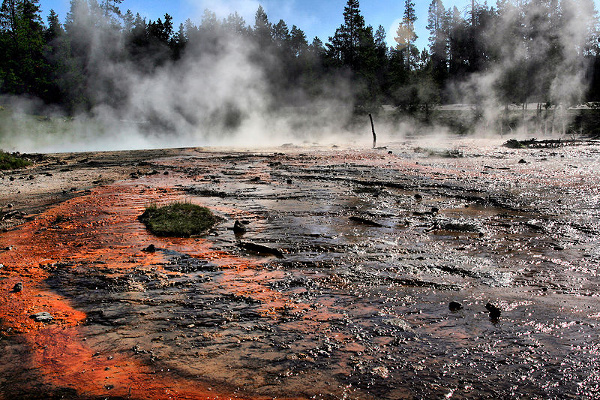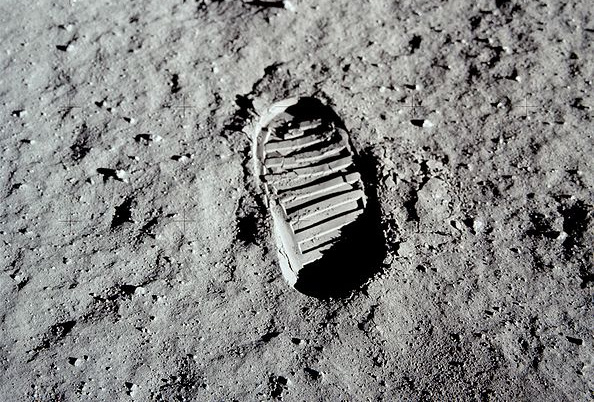Fountains of the Deep
November 24, 2010
A recurrent theme on the
Doctor Who television series is unusual things being uncovered while drilling deep into the
Earth. The most recent of these is
The Hungry Earth (May 22, 2010); but an earlier episode,
Inferno (June 20, 1970), is more relevant to the topic of this article. That episode involves very deep drilling to release an energy source called Stahlman's Gas. Instead, the drilling releases a green slime with potent
mutagenic properties.
We've sent men a quarter of a million miles to explore the
Moon, but we know very little about what's just a few miles below our feet. When I was in high school, there was a much publicized deep sea drilling project called
Project Mohole, the purpose of which was to examine the region between Earth's
crust and
mantle called the
Mohorovicic discontinuity. This region is only 3-6 miles below the ocean floor, but it extends up to 60 miles below some continents.
Shortly after Mohole, in 1970, the
Kola Superdeep Borehole commenced drilling at
Kola Peninsula in
Russia. The deepest borehole reached 7.62 miles in 1989, and this is the deepest borehole ever drilled. Perhaps chastened by Doctor Who's experience, no deeper holes have been drilled since that time, a span of more than twenty years.
A recent paper in
PLoS ONE from an international research team with members from the
United States,
Japan and
Germany, reports on finding
bacteria unexpectedly deep inside the Earth's crust. These bacteria were found in the
gabbroic layer below the
Atlantic Ocean. This layer is close to the seafloor in the
mid-Atlantic, a region called the
Atlantis Massif, so it was only necessary to drill down 1391 meters (0.86 mile). The temperature at this level was 102
oC, just slightly above the boiling point of water. There are known
thermophile bacteria that survive such temperature.

Silex spring in Yellowstone National Park, a haven for thermophile bacteria. (photo by Mila Zinkova).
The Atlantis Massif (30
o 8' N, 42
o 8' W) is the location of expeditions numbers 304 and 305 of the
Integrated Ocean Drilling Program, sponsored by the
National Science Foundation and other agencies. Just as surprising as finding bacteria was the type of organism found.
Archaea, an ancient branch of the evolutionary tree formerly considered to be a type of bacteria but now a separate organic domain, were expected. However, the bacteria were similar to the type found higher in the crust, in
basalt. One major difference was that these gabbronic bacteria had evolved to metabolize
hydrocarbons, such as
toluene and
methane. A genetic analysis showed genes that coded for
anaerobic respiration, such as
nitrate reduction,
sulfate reduction, and
metal reduction, as well as
nitrogen fixation. It's conjectured that the hydrocarbons on which these bacteria feed arise abiotically from reactions involving carbon deep within the Earth's crust. This means that these bacteria survive independently of the
biosphere above, and suggests that bacteria could survive even deeper within the Earth.
Having mentioned abiotic genesis of hydrocarbons in a blog that also presents articles about
astronomy, I'm obligated to mention
Tommy Gold. Gold (May 22, 1920 - June 22, 2004) is well known in astronomy for his collaboration with
Fred Hoyle on the theory of
steady state cosmology. He was elected a member of the
U.S. National Academy of Sciences, and he was named a Fellow of the
Royal Society, so his scientific credentials were quite good. Perhaps his association with Hoyle encouraged him to speak his mind when the data seemed to warrant it, even when other scientists didn't see things his way. He proposed that the surface of the Moon would be like a powder and perhaps dangerous to
astronauts. This theory was somewhat vindicated when men actually stepped onto the Moon's surface and left impressive boot marks, considering the low
gravity condition.

Footprint of Buzz Aldrin on the Moon
One of Gold's other interests was the
abiogenic genesis of petroleum, the idea that most
petroleum comes from deep
carbon deposits, left during the formation of the planet, and not from vegetation. Gold's theory excited the interest of some
Russian scientists when it was first proposed, but it's now mostly discredited.
References:
- Olivia U. Mason, Tatsunori Nakagawa, Martin Rosner, Joy D. Van Nostrand, Jizhong Zhou, Akihiko Maruyama, Martin R. Fisk, and Stephen J. Giovannoni, "First Investigation of the Microbiology of the Deepest Layer of Ocean Crust," PLoS ONE, vol. 5, no. 11 (November 5, 2010), document e15399.
- Michael Marshal, "Life is found in deepest layer of Earth's crust," New Scientist, Issue 2787 (November 18, 2010).
Permanent Link to this article
Linked Keywords: Doctor Who; Earth; The Hungry Earth; Inferno; mutagenic; Moon; Project Mohole; crust; mantle; Mohorovicic discontinuity; Kola Superdeep Borehole; Kola Peninsula; Russia; PLoS ONE; United States; Japan; Germany; bacteria; gabbroic; Atlantic Ocean; mid-Atlantic; Atlantis Massif; thermophile bacteria; Silex spring in Yellowstone National Park; Integrated Ocean Drilling Program; National Science Foundation; archaea; basalt; hydrocarbons; toluene; methane; anaerobic respiration; nitrate; reduction; sulfate; metal; nitrogen fixation; biosphere; astronomy; Thomas Gold; Tommy Gold; Fred Hoyle; steady state cosmology; U.S. National Academy of Sciences; Royal Society; astronauts; gravity; footprint of Buzz Aldrin on the Moon; abiogenic genesis of petroleum; petroleum; carbon; Russian.